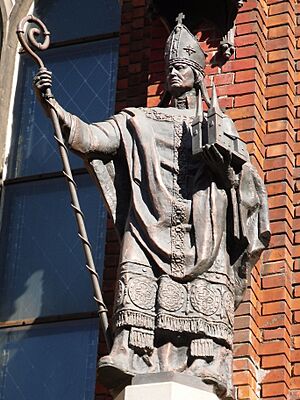Albert of Riga facts for kids
Quick facts for kids
Albert of Riga
|
|
|---|---|

Albert of Riga, copy of a sculpture by Karl Hans Bernewitz on the facade of Riga Cathedral
|
|
| Born | c. 1165 Bexhövede, Lower Saxony, Germany
|
| Died | 17 January 1229 |
| Nationality | German |
| Other names | Albert of Bexhövede, Albert of Buxhoeveden |
| Occupation | Bishop of Riga |
| Known for | Founding the city of Riga, Livonian Crusade |
| Title | Prince-Bishop of Livonia |
Albert of Riga (born around 1165, died 1229) was an important bishop who helped spread Christianity in a region called Livonia. He is famous for founding the city of Riga, which is now the capital of Latvia, in 1201. He also started building the impressive Riga Cathedral in 1221.
Albert led groups of people, sometimes with armed forces, to introduce Christianity to the local people in the eastern Baltic region. This was part of a larger movement known as the Northern Crusades.
Who Was Albert of Riga?
Albert was born in a place called Bexhövede in Germany. He came from a powerful family known as the Buxhoeveden family. Because of his family name, he was also known as Albert of Buxhoeveden.
Albert was a canon, which is a type of priest, in Bremen. His uncle, Hartwig of Uthlede, who was the Archbishop of Bremen, chose Albert to become the Bishop of Livonia. This was a big job! Albert had to be able to take control of the area and convince the local people to become Christians.
In 1199, Albert received official permission for his mission. In the spring of 1200, he set sail for Livonia. He had a large fleet of 23 ships and more than 1,500 crusaders (people who joined a religious military expedition). He had support from the German king, Philip of Swabia, and also from Pope Innocent III.
In 1200, Bishop Albert began his mission in Livonia. He arrived with a strong army in a place called Ikšķile. Albert had special rights that allowed him to send more crusaders to Livonia each year. This led to an annual summer trip from Lübeck to Livonia, which was called the "perpetual crusade."
Founding the City of Riga
Albert soon realized that his first base in Ikšķile was too far from the Daugava river to be effective. He decided to build a new settlement closer to the sea. This new place was where a small stream met the Daugava, creating a natural harbor. This new settlement would become the city of Riga.
In 1201, Albert, along with merchants from the island of Gotland, officially founded Riga. There was already a small group of traders from Lübeck there. In 1204, the Pope gave Albert permission to recruit even more crusaders.
Albert was successful in converting many Livs, who were local people, to Christianity. Their leader, Caupo, even joined Albert. Albert offered them protection from neighboring tribes like the Lithuanians and Estonians. Over time, Albert also brought other Latvian areas, like Koknese, Jersika, and Tālava, under his control. Taking over Livonia completely took almost 30 years of his life.
Albert also created a military order called the Livonian Brothers of the Sword. This was a group of knight-monks who helped protect and expand the Christian territories. In 1215, he began building his grand Riga Cathedral.
King Philip of Germany made Albert a Prince of the Holy Roman Empire. This meant Albert became a "Prince-Bishop" and ruled Livonia as his own territory. In 1225, King Henry (VII) of Germany confirmed this important title for Albert and his brother, Hermann. Albert also declared his diocese (his church territory) independent from Bremen. Later, Riga became an archbishopric, which is an even more important church region.
A detailed story of Albert's life and work can be found in a book from that time called the Livonian Chronicle of Henry, written by Henry of Latvia.
Albert died in Riga in 1229. As a Catholic bishop, he did not have any children. He was considered a saint by Catholics for a long time, until the Protestant Reformation. Today, a street in Riga, Albert Street, is named after him.

